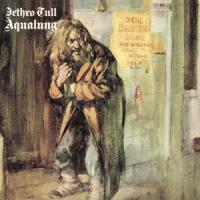Classic's Long Awaited Aqualung Finally Released!
Ian Anderson himself may wonder why people are still interested in Aqualung thirty-six years after it was first releasedor maybe not. Though almost comically simple, the opening riff to the title cut is one of rock�s most ingenious and indelible. The contemplative album is packed with memorable melodies expressing anger, nostalgia, pity, regret, tenderness and contempt.
Anderson totally jettisons his Roland Kirk and hyper-blues affectations for a neat blend of acoustic folk and electric rock and he knows how to shift the ensemble into spirited overdrive.
Ian Anderson himself may wonder why people are still interested in Aqualung thirty-six years after it was first releasedor maybe not. Though almost comically simple, the opening riff to the title cut is one of rock's most ingenious and indelible. The contemplative album is packed with memorable melodies expressing anger, nostalgia, pity, regret, tenderness and contempt.
Anderson totally jettisons his Roland Kirk and hyper-blues affectations for a neat blend of acoustic folk and electric rock and he knows how to shift the ensemble into spirited overdrive.
The arrangements are supple, the production is clean and the recording is intimate and well-organized, though bass is on the light side for a riff-oriented rock record.
I compared Classic's new 200g reissue with: 1) an original UK Chrysalis 2) an original American Chrysalis/Warner Brothers, 3) an original French Pink Label Island, 4) The Mobile Fidelity ' speed mastered edition and 5) DCC's 180g issue mastered by the team of Hoffman and Gray.
Now rather than make value judgments, let's just compare without prejudice. First of all, the EQ on the Mo-Fi is extreme: the bass has been boosted to cartoon levels and the upper mids have a presence region peak. Very 'hi-fi' and the intimacy and warmth of Anderson's voice is sacrificed to edge and sibilants. My least favorite, though the surfaces are dead quiet and the transients, as you'd expect from half-speed mastering, are clean and precise. On some systems, (bass shy, midband rich), the Mo-Fi could sound great.
The UK Chrysalis is somewhat disappointing, with harsh and overly large vocals plus somewhat brittle acoustic guitars. Overall, pretty good though, especially the tight and not overdone bass. I like the French Pink Label Island, for its warmish midrange and expressive acoustic guitars. It captures the intimacy I think Anderson wanted for his vocals and the crystalline, though warm bodied acoustic guitars.
The original American Warner Brothers/Chrysalis has the most coherent tonal balance of all of the commercial releases, with a rich midband and reasonably good extension. However, it sounds dynamically compressed and lacks ultimate clarity and focus
As for the DCC, I would never bet against the house of Hoffman/Gray, then operating at Artisan and the DCC is a model of good EQ taste and clarity, plus a fine 180g RTI pressing. Just for the hell of it, I also listened to the DCC gold CD. Give me a break! Martin Barre plays a descant recorder (a small, inexpensive wooden wind instrument in the key of C) on, among other tracks 'Mother Goose.' It's 'flutey' and 'woody' and 'airy' and 'round' on all of the LP editions. You can barely hear it on the CD.
However, the new Classic, cut from the original master tape loaned to Classic by Mr. Anderson himself, and not previously used by anyone to cut a lacquer, to the best of my knowledge, has it all. Cut by Chris Bellman at Bernie Grundman's, the new version has warmth, extension, focus, clarity, dynamics and everything else you'd want.
Understand: like Acoustic Sounds' release of Yes's Fragile, Aqualung was not a great recording to begin with. It is somewhat bass shy, though the very bottom is surprisingly robust and if your system goes all the way down, you'll hear it on the Classic without the muck and mud added by too much low end EQ on some of the others.
This newest Aqualung is the definitive version and if you love this record, it's worth the money. You will hear musical details and colors not previously revealed on any other version and Mr. Anderson's vocals will literally be in your lap, they are so purely and intimately rendered on Bellman's cut. On no other version do the acoustic guitars have both believable attack and sustain.
As for the pressing quality, perhaps you've heard about Classic's recent 'hiccup,' or have had complaints about lead-in groove noise and/or warps on some Classic releases, especially the recent Norah Jones and Diana Krall.
Without going into all of the details, Classic has been 'experimenting' with pressing plants other than RTI and as with any 'start-up' operation, there have been difficulties. Indeed, pressing 'flat' lipless (no groove guard) 200 gram LPs is inherently problematic. By 'flat' I mean that the groove area does not dip down to the halfway point and up the rest of the way, as do all other LPs, 180 gram or whatever. Pressing flat is laudable as it eliminates azimuth and other errors caused by 'downhill' and 'uphill' travel. However, getting vinyl to flow properly to the outer grooves is tricky, and made even trickier by Classic's insistence on no 'groove guard' or outer lip. That profile allows some vinyl to flow in the tool beyond the edge of the record, creating noise and other issues.
So, Classic has re-tooled its tools to produce a slight lip that you will see on this and future Classic records. However, the records retain the flat profile and 200 gram weight. If the sealed pressing of Aqualung I received is typical of what we can expect from Classic going forward, I think everyone will be pleased. The record was perfectly flat and absolutely silent.
Finally, Classic has spared no expense in reproducing the original LP's textured linen finish. You get the look and feel of the original UK issue with better sound.



